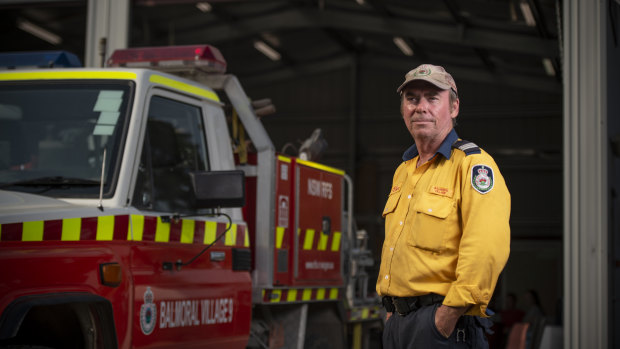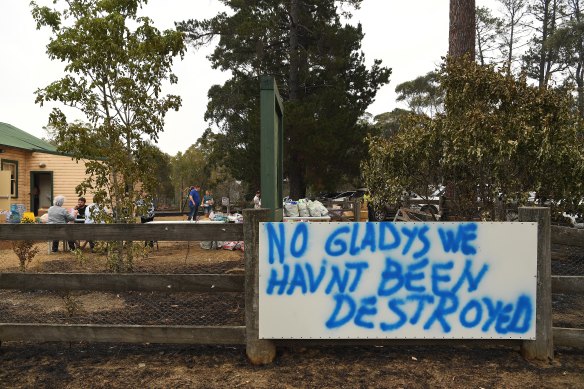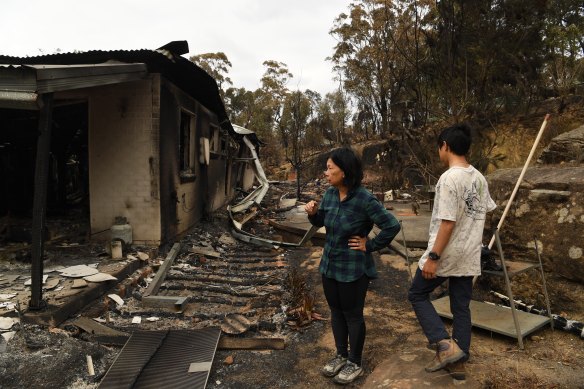By Sally Rawsthorne and Wolter Peeters
Balmoral Rural Fire Service captain Brendan O’Connor believes an over-reliance on computer modelling and a failure by the RFS to take on local knowledge allowed the Green Wattle Creek fire to decimate the Southern Highlands hamlet.
“The RFS abandoned our village,” Mr O’Connor told The Sun-Herald from the Balmoral RFS shed, three weeks after the fire burnt through the 450-strong town south of Picton.

Balmoral village RFS Captain Brendan O'Connor at the volunteers' fire shed. "It was a time bomb waiting to go off.”Credit: Wolter Peeters
A 20-year veteran of the brigade, Mr O’Connor said he told the RFS that hazard reduction burns were necessary in certain areas, but the RFS’ computer modelling said they were not required.
“The only thing I was told was the hazard reduction at Centre Ridge in the National Park would be enough to slow it down, so we could stop it.
“The problem is, there’s still four ks of bush between that and the village. It came through as a wild fire, it crowned through that and had a four kilometre run into the village. There’s been nothing done in that area since 2001, we’d had 18 years of fuel growing on the ground. It was a time bomb waiting to go off.”
The fire ravaged the tiny Southern Highlands township 10 times over three days, taking with it 20 homes. The town is reliant on tank water, which ran out part way through the intense fire fight.

Balmoral residents are determined to rebuild in the aftermath of the Green Wattle Creek fire.Credit: Kate Geraghty
Returning to the RFS shed to make desperate calls for water, Mr O’Connor encountered a scene “like out of a movie”.
“There were firefighters falling down everywhere, out of sheer exhaustion and devastation. There were 10 or so, just laying down on the ground. There were firefighters helping other firefighters, it was quite intense,” he said.
Since the blaze – so hot the perspiration in the sweatband of Mr O'Connor's helmet boiled, leaving him with blisters across his forehead – he says the community has remained “on its own” on every level.
NSW Premier Gladys Berejiklian and Prime Minister Scott Morrison visited an evacuation centre at Picton, 20 kilometres from Balmoral, the day after the fire.

The remains of a home on Station Street, Balmoral. The fires destroyed 20 houses.Credit: Kate Geraghty
Ms Berejiklian said there "was not much left" of the town, which still has more than 100 homes standing.
“The RFS haven’t been here either,” said Mr O'Connor. “One bloke turned up and just poked his head in, then left.”
A veteran of the Black Saturday fires that ravaged Victoria and “most other major fires in the country”, Mr O’Connor said he had never seen anything like the Green Wattle Creek fire before. “I can’t describe it.”
RFS media manager Inspector Ben Shepherd said that local Bush Fire Management Committees worked with locals to identify risks and ways of treating them, such as hazard reduction. The committees included local representatives of the NSW RFS, volunteer firefighters, land managers and councils.
"Hazard reduction is not just about burning and can include hand clearing or mechanical works such as mowing or slashing," said Inspector Shepherd. He said the RFS also considered other issues including the impact of smoke, and on local flora and fauna.
A number of hazard reductions had occurred around Balmoral including two burns directly to the west of the Village in May 2019 and in September 2010. There were also burns to the south west of the village in August 2017 and September 2010.
But completing hazard reduction activities was highly weather dependent, with limited windows of opportunity, said Inspector Shepherd. Longer fire seasons in southeast Australia had reduced the opportunities for fuel reduction burning.
Balmoral RFS volunteer Victoria Herrera lost her house to the Balmoral blaze. “I had my passport, some clothes. I got my dogs out,” she said.
She has been staying in her daughter’s spare room at Narellan ever since. “But I want to be here,” she said.
“There’s no doubt I’ll rebuild, but I don’t know where to begin. I’m a single person, and I don’t know anything about demolition or anything like that,” she said.
Like her captain, Ms Herrera is worried about the brigade and the wider Balmoral community.
“The fire took 90 per cent of the trees. You can’t even go for a walk – not that you’d want to at the moment, because of the [potential for falling] trees,” she said.
She is also angry about the authorities’ treatment of the town.
“The tree clearing, that’s crucial. But the tree clearers are still on the mid-north coast, where the fires went a few months ago. When will they come here?
“We're not going to sit here and wait for the government to do everything for us, because I’ve got nowhere to live.”